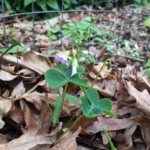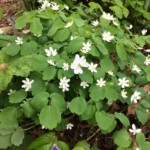Notes from the Understory
Recreating woodlands in your backyard
Our (under)story
For the past several years, we have been working on a garden inspired by the natural community that might have been here before residential development—probably a Piedmont Oak-Hickory Woodlands. The idea was to use native plants to help support wildlife, from the microbiome all the way up to the neighborhood’s birds and mammals. And that the best way to do that would be to draw on plant communities that were best adapted to the challenging conditions here like the long, hot summers and the shade under several large trees.
Resources
It wasn’t obvious how to narrow this down, but with some help from experts like VNPS Potowmack Chapter board member Rod Simmons, we settled on the Piedmont Oak-Hickory natural community, and then looked up descriptions in studies done by The Flora Project of Alexandria under Rod Simmons here and by the Virginia Department of Conservation and Resources here. There is good intro information at the Plant NOVA Natives website, too. We also spend a lot of time double-checking the Arlington native status of plants at the Digital Atlas of Virginia Flora.
Plants
I am working on a full list of plants we have in our yard, which will have notes on placement, natural habitat, bloom times, water use, etc. This is a work in progress, and draws heavily on some of my favorite websites, including the Digital Atlas of Virginia Flora, Go Botany (has great notes for distinguishing similar plants), the Lady Bird Johnson Wildflower Center, the Missouri Botanical Garden, the Illinois Wildflowers page (search bar is at the bottom), and Native Plants of the Carolinas & Georgia.
May 2018—Rainstruck
The summer plants that seemed cautious about the colder weather in April jumped out within days of the four inches of rain we got in recent days, and have started giving the spring ephemerals some competition.
By Dean Arkema













Dean,
Would you be willing to share more details about the format of your plants list? Wondering what works best for you.
I have experimented with Excel spreadsheet(s); one for each type of plant (ie: trees, bushes, vines, grasses, ferns, perennials, etc.)
Thanks for the inspiration to get my woodland garden documented.
Thank you for the inspiration, Dean. Oaks (and tulip poplar) predominate in my Fairfax County neighborhood, and you have brought my experiments to a higher level.